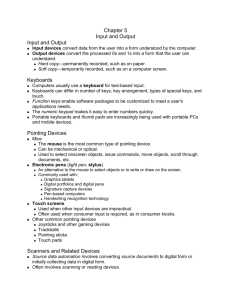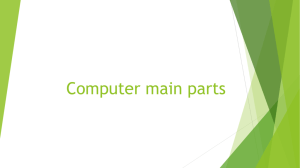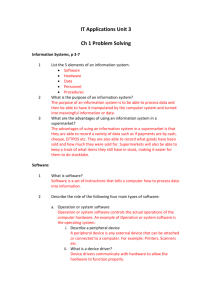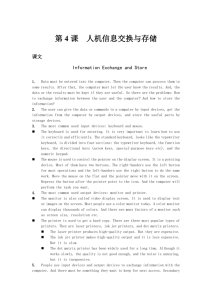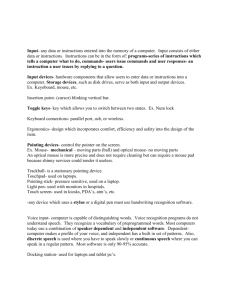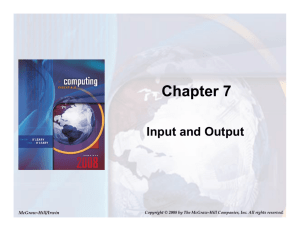ic3_chapter_2
advertisement
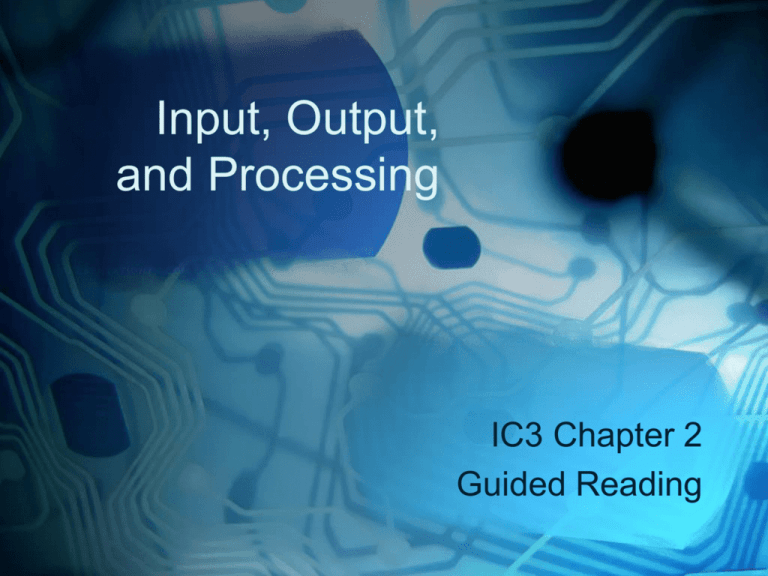
Input, Output, and Processing IC3 Chapter 2 Guided Reading Question 1 • Input, which ____________________________, must be entered into the computer and then stored on a storage media device. • Data or Instructions Question 2 • To turn the data into information, _______________ processes the data. • Central Processing Unit (CPU) Question 3 • After data is processed, it is “presented” to the user through an ____________________________ • Output Device Standard Input Devices Question 4 • Input devices allow you to___________________________. • Enter data and commands into the computer Question 5 • The most commonly used input device is the ___________________. • Keyboard Types of Keyboards • • • • • Ergonomic Cordless or Wireless Specialized Security Foldable or Flexible Question 6 • An input device that allows you to position the pointer on the screen is a ____________________. • Pointing Device Question 7 • ________________ is the most commonly used pointing device. • The Mouse Question 8 – Define and Provide Examples of the Following: • Trackball • A Pointing Device that works like a mouse turned upside down with the ball on top. Question 8 – Define and Provide Examples of the Following: • Touchpad • A pointing device with a specialized surface that can convert the motion and position of your fingers to a relative position on the screen. Question 8 – Define and Provide Examples of the Following: • Pointing Stick • A pressure sensitive device that looks like a pencil eraser. It is located on the keyboard, generally between the G, H, and B keys. Question 8 – Define and Provide Examples of the Following: • Audio Input • The process of inputting sound into the computer. This could include speech, sound effects, and music. Devices include microphones, CD/DVD players, radios, and other hardware such as electronic keyboards. Standard Output Devices Question 9 • _________________is data that has been processed into a useful format. Output devices display information. • Output Question 10 • ____________________ is a Display device for a desktop computer. Varieties include CRT, LCD, and gas plasma. • A Monitor Types of Monitors • Cathode Ray Tube (CRT) • Similar to a standard television, it has a one color display, which can be white, green, or amber. Types of Monitors • Liquid Crystal Display • Produces an image by manipulating light within a layer or liquid crystal cells. Types of Monitors • Gas Plasma • Consists of a tiny amount of gas that is activated by an electrical charge, which manipulates colored fluorescent lights arranged in a panel-like screen. Question 11 • _________________are used to produce a paper or hard copy of the processing result. Consider speed, print quality, and price when choosing. • Printers Question 12 • ___________________ produce highquality output using the same technology as copier machines. • Laser Printers Question 13 – Define The Following • Inkjet Printer • Provides good quality color printing for less expense than a laser printer. Question 13 • Speakers • A type of output device, Speakers generate sound that is output from the computer and other devices. Portable speakers are known as headsets. Specialized Input Devices Question 14 – Define the Following • Digital Camera • Take and store pictures digitally and then transferred to a computer’s memory. Digital cameras use a variety of storage media to store the images including flash memory cards, memory sticks, USB keys, minidiscs, and other solidstate storage devices. Question 14 • Game Controller • A type of pointing device, game controllers include Joysticks and Wheels. Question 14 • Scanners / Bar Code Readers • Scanners are devices that can change images into codes for input to the computer. Types of scanners include image scanners, bar code scanners, magnetic scanners, wireless scanners, optical character recognition and optical mark recognition. Image Scanners • These devices convert images into an electronic form that can be stored in a computer’s memory where it can be manipulated. Bar Code Scanners • Reads bar lines that are printed on products. An example is a scanner at a grocery store at the check-out lane. Magnetic Scanners • These devices read encoded information on the back of credit cards. This information is the owner’s account number. Wireless Scanners • A Bluetooth barcode scanner uses Bluetooth wireless technology to scan data and transmit it to a computer. An example includes a scanner at a hospital. OCR and OMR • These optical devices use a light source to read characters, marks and codes. Banks use OCR (optical character recognition) to scan checks and OMR (optical mark recognition) is used for Scantron tests. Question 14 • Touch Display Screen • A special screen with pictures or shapes that you can use your finger to “point” to the desired object to make a selection. You can find these screens on ATM’s, in hotels, airports, delivery services, and in mobile devices. Question 14 • Stylus • A stylus and digital pen are pen-like writing instruments. These devices allow you to input information by writing on a PDA or other mobile device, using the pen as a pointer. Question 14 • Environmental Probes / Sensors • Workers use environment probes and sensors with a standard web browser to view elements such as the temperature and humidity of a remote environment, smoke detector readings, pollution control readings, and so on. Industries such as farming, tropical fish production, moisture monitoring, and warehouse security use environmental probes and sensors to help stabilize work areas. Question 14 • Remote Controls • A specialized input device used for numerous standard applications such as television, lights, fans, and so on. Also used for purposes such as operating cranes on a construction site and operating product carts in warehouses. Question 14 • Security Devices • In information technology, biometrics is an authentication technique using automated methods of recognizing a person based on physiological or behavioral characteristics. Consists of a reader or scanning device and software that converts the scanned information into a digital format. The scanned information then is compared to a database of stored biometric data. The steps in this process are enrollment, submission, and verification. Question 14 • Virtual Devices • Virtual devices use the synchronized positioning of light-emitting and sensing devices to detect user input. Examples include a virtual keyboard or a virtual piano keyboard. Question 14 • Touch Sensitive Pads • The touch sensitive pad on a portable device, such as an iPod, enables you to scroll through a list, adjust the volume, play music, view videos or pictures, and customize settings. Question 14 • Input Devices for the Physically Challenged • Keyboards operated with one hand or with the feet, Camera Mouse enables users to use a webcam to control the mouse pointer by moving their heads, a humancomputer interface that uses eye control to move a pointer and make selections Specialized Output Devices Question 15 – Explain the Following • Projectors • A data projector projects the computer image onto a screen; this is most commonly used for presentations. Question 15 • Fax Machines • A fax machine and fax modem transmit and receive documents over a telephone line or through a computer. Question 15 • Multi-function printers • A multifunction printer combines various outputs options such as printing, scanning, copying, and faxing. Question 15 • Control Devices / Robots • Robotics is defined as the study, design, and use of robot systems for manufacturing. Typical applications include testing, product inspection, painting, assembly, and packaging. Question 15 – Specialized Printers • Dot Matrix Printer • Transfer ink to the paper by striking a ribbon with pins. The higher amount of pins, the better the print quality (dpi). Usually attached to large computers such as mainframes or midrange servers. Question 15 – Specialized Printers • Thermal Printer • Forms characters by heating paper. The printer requires special heat-sensitive paper. Question 15 – Specialized Printers • Mobile • Small, battery powered printer generally used with notebook computers. Question 15 – Specialized Printers • Label and Postage • Prints various types of labels on adhesive paper. Postage print stamps and contains a built-in digital scale. Question 15 – Specialized Printers • Plotters/Large Format • Engineers, architects, and graphic artists use these for drawings and drafting output. Question 15 • Output Devices for the Physically Challenged • Screen Magnifiers – These devices contain a range of magnifications and a variety of fonts and are used to enlarge the information on the computer screen. • Screen Readers – Assists people who are blind or visually impaired by using a speech synthesizer to read screen content. Question 16 • ________________is an interface to which a peripheral device ____________________________with the system unit. • Port • Attaches Question 17 • For most hardware devices to work, they need a set of ________________that communicates with the computer’s operating system, called___________________. • Instructions • Drivers Question 18 • If the operating system already contains the driver, it performs an _______________installation for newly connected devices. • Automatic Question 19 – How Do These Effect Computer Performance? • Microprocessor • CPU’s are classified as generations, and the higher the generation, the faster and better the processing speed. In other words, the faster the processor, the more instructions per second it can process. Question 19 – How Do These Effect Computer Performance? • RAM • The amount of RAM also helps to increase the processing cycle and to enhance the computer’s performance. When the memory capacity is reached, the CPU stores data on the hard drive. This slows down the processing cycle because it takes longer for the CPU to read from a hard drive than the RAM. Question 19 – How Do These Effect Computer Performance? • Hard Drive • The bigger and faster the hard drive, the faster data can be processed. Organization of the hard drive also effects computer performance. Question 19 – How Do These Effect Computer Performance? • Video Card • Can slow down or speed up computer performance. Having adequate video memory for the video card allows the processor to perform to its full potential.
